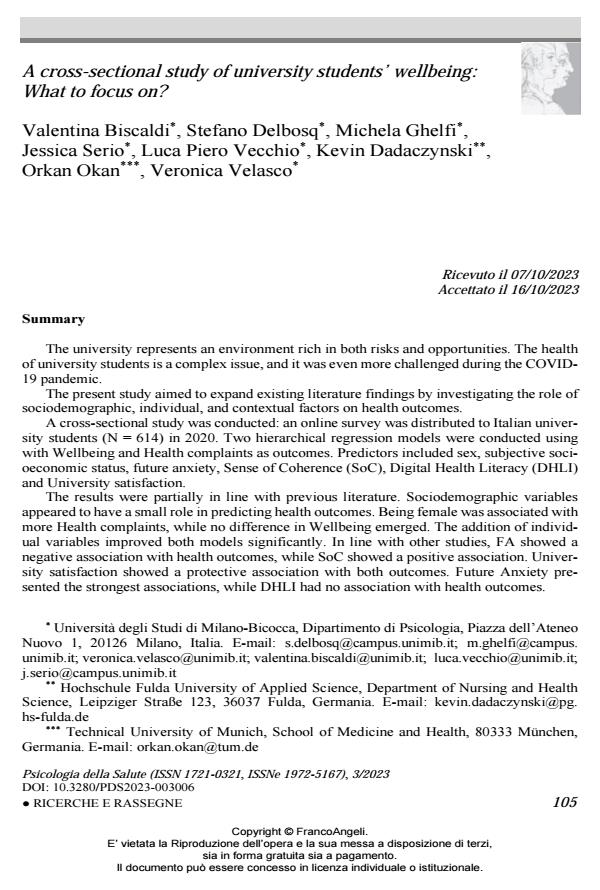A cross-sectional study of university students’ wellbeing: What to focus on?
Journal title PSICOLOGIA DELLA SALUTE
Author/s Valentina Biscaldi, Stefano Delbosq, Michela Ghelfi, Jessica Serio, Luca Piero Vecchio, Kevin Dadaczynski, Orkan Okan, Veronica Velasco
Publishing Year 2023 Issue 2023/3
Language English Pages 20 P. 105-124 File size 256 KB
DOI 10.3280/PDS2023-003006
DOI is like a bar code for intellectual property: to have more infomation
click here
Below, you can see the article first page
If you want to buy this article in PDF format, you can do it, following the instructions to buy download credits

FrancoAngeli is member of Publishers International Linking Association, Inc (PILA), a not-for-profit association which run the CrossRef service enabling links to and from online scholarly content.
The university represents an environment rich in both risks and opportunities. The health of university students is a complex issue, and it was even more challenged during the COVID-19 pandemic. The present study aimed to expand existing literature findings by investigating the role of sociodemographic, individual, and contextual factors on health outcomes. A cross-sectional study was conducted: an online survey was distributed to Italian univer-sity students (N = 614) in 2020. Two hierarchical regression models were conducted using with Wellbeing and Health complaints as outcomes. Predictors included sex, subjective socio-economic status, future anxiety, Sense of Coherence (SoC), Digital Health Literacy (DHLI) and University satisfaction. The results were partially in line with previous literature. Sociodemographic variables appeared to have a small role in predicting health outcomes. Being female was associated with more Health complaints, while no difference in Wellbeing emerged. The addition of individual variables improved both models significantly. In line with other studies, FA showed a nega-tive association with health outcomes, while SoC showed a positive association. University satisfaction showed a protective association with both outcomes. Future Anxiety presented the strongest associations, while DHLI had no association with health outcomes. This confirmed the literature’s findings that different factors can influence university stu-dents’ wellbeing and that universities can have an important role in promoting it.
Keywords: Wellbeing, university students, satisfaction, sense of coherence, COVID-health literacy network.
Valentina Biscaldi, Stefano Delbosq, Michela Ghelfi, Jessica Serio, Luca Piero Vecchio, Kevin Dadaczynski, Orkan Okan, Veronica Velasco, A cross-sectional study of university students’ wellbeing: What to focus on? in "PSICOLOGIA DELLA SALUTE" 3/2023, pp 105-124, DOI: 10.3280/PDS2023-003006